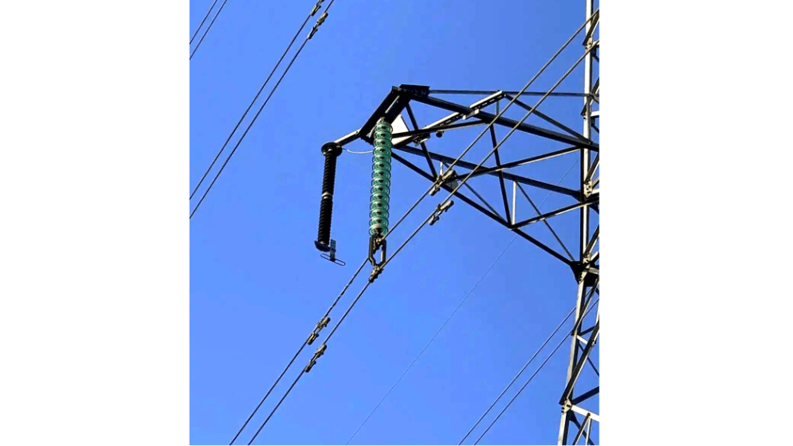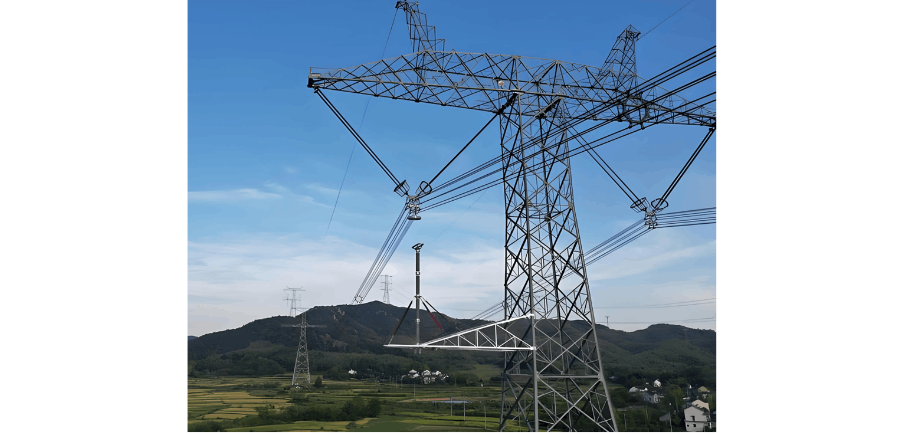Ang mga Surge Arresters ug ang Ilahang Pag-evolve
Ang surge arrester adunay kasinatian nga giparalelo sa electrical equipment nga gigipotan. Wala kini mohimo og interbensyon sa normal nga operasyon sa equipment sa system voltage. Apan, kon may dangong overvoltage nga mogawas sa equipment, ang arrester ang unang magdagan, nagsalbar sa overvoltage nga mobag-o ngadto sa yuta.
Ang pinakauna ug pinakasimple nga tipo sa surge arrester gitukod sa duha ka metal rods nga giseparate sa usa ka gap ug giparalelo sa electrical equipment. Kon ang voltage sa gap ini gibabaw sa isip threshold, ang hangin (ang gap) mahimong mogawas, nagprotekta sa equipment. Kini nga tipo sa arrester gitawag og "expulsion gap" o "protective gap."
Ang phenomenon sa lightning sama ra: ang thunderclouds ug ang yuta nag-act isip duha ka conductors (electrodes). Kon ang voltage sa ilaha gibabaw, ang hangin sa ilaha mogawas, resulta ang lightning strike.
Apan, adunay importante nga pagkakaiba. Ang protective gaps giparalelo sa power lines. Kon ang dangong overvoltage mosabot sa breakdown sa gap (i.e., ang hangin sa duha ka rods gi-ionize), ang power plant o substation wala makahibalo sa event niini - o dili makapabilis nga reaksiyon. Kasagaran, nagpadayon sila sa pag-supply og current sa na-conducting gap. Tungod kay ang gap naghatag og ruta ngadto sa yuta, ang current mosulob pinaagi sa continuous, nagresulta sa short circuit sa power system. Busa, taliwala og simple ang paggamit sa protective gaps, ang ilahang operasyon nagresulta sa sustained arc sa gap, nag-lead sa short-circuit condition.
Unsaon ang pag-extinguish sa arc sa protective gap pinaagi sa maong operasyon? Kini mianghigayon sa pag-develop sa ikaduhang henerasyon sa arrester - ang expulsion (o tube-type) arrester. Kini nga disenyo unang nakonfini sa arc sa usa ka tube ug pagkatapos mopamalihok sa paraan sa pag-extinguish niini.
Apan, ang expulsion arresters gihapon adunay drawback: bisan unsa ang ilahang capability sa pag-extinguish sa arc, gihapon sila nagdala sa power system current diretso ngadto sa yuta, nagresulta sa momentary earth fault (short circuit).

Ang ideal nga solusyon mao ang device nga mag-block sa current o molabay lang minimal leakage sa normal nga voltage, busa wala mag-short circuit, apan rapid nga magdagan sa dako nga surge currents (like lightning) ngadto sa yuta kon dangong overvoltages mogawas. Sa simple terms, kini nga device mag-act isip "intelligent switch," kabalo unsa ang oras sa pag-open ug close. Sa surge arresters, kini nga "intelligent switch" unang girealize gamit ang material nga silicon carbide (SiC). Ang arresters gihimo gikan kini nga materyales gitawag og valve-type arresters, tungod kay sila nag-operate isip electrical valves.
Importante nga masulti nga kini nga "valve" usa ka electrical component, dili mechanical valve sama sa faucet o pipe valve. Ang mechanical valves grabe kaayo ka dili basta-basta sa pag-respond sa lightning, nga mogawas sa microseconds. Bisag unsa, kinahanglan ang electrical "valve" gikan sa non-linear resistor. Ang silicon carbide ang unang non-linear resistor material nga nahitabo para sa high-voltage applications.
Ang teknolohiya nag-evolve sa continuous. Nakadiskubre usab ang ikaduha nga non-linear resistor material para sa surge arresters: ang zinc oxide (ZnO). Kini nag-serve og similar nga function sa silicon carbide apan adunay superior nga "valve" characteristics - professionally described as having better non-linearity.
Unsa ang non-linearity? Figuratively, kini nagpasabot og pag-contrary: small kon dapat large, ug large kon dapat small - dili sama sa linear components, nga proportional sa scale.
Sa surge arresters, ang non-linearity manifest isip sulod: kon ang current dako (e.g., sa panahon sa lightning surge), ang resistance mubaba, ug ang mubo ang resistance, ang mas maayo ang non-linearity. Kon ang current baho (human sa lightning surge napuyo ug ang system mobalik sa normal nga operating voltage), ang resistance mobata, ug ang mobato ang resistance, ang mas maayo ang non-linearity.
Ang silicon carbide adunay non-linearity, apan dili ideal. Sa normal nga operating voltage, ang resistance dili kaayo mobata, naghatag og small leakage current sa arrester - sama sa valve nga dili maayo nga mag-close, nagresulta sa continuous "trickle" sa current.
Kini nga behavior inherent sa materyal, ug ang mga efforts sa pag-improve sa materyal wala kaayo successful. Busa, sa paggamit sa silicon carbide sa arresters, structural solutions ang gipamalihok: ang arrester unang isolated gikan sa line ug giconnect lang human sa surge. Kini nga task gibuhat pinaagi sa series air gap. Busa, ang valve-type arresters kasagaran nagkinahanglan og gap. Sa katuyuhan, ang zinc oxide valves "close tightly" sa normal nga operating voltage, busa wala sila nagkinahanglan og series gap.
Tungod sa improvement sa zinc oxide manufacturing technology, ang early limitations sa "closing" capability natapos. Apan, tungod sa historical prevalence sa gapped designs, ang uban pa gihapon sa zinc oxide arresters adunay gaps. Busa, ang gapless zinc oxide arresters ang majority.
Tungod kay ang zinc oxide usa ka metal oxide, kini nga arresters gitawag usab og Metal Oxide Surge Arresters (MOSA).
Ang Lightning Protection sa Power Systems
Gikan sa perspective sa lightning protection devices, ang tatlo ka main types mao ang: lightning rods (air terminals), overhead ground wires (shield wires), ug surge arresters. Ang unang duha structurally simple - essentially just rods ug wires - apan ang latter mas komplikado tungod sa iyang reliance sa non-linear resistors nga nag-act isip "intelligent switches."
Gikan sa perspective sa protected objects, ang lightning protection mahimong icategorize isip: overhead transmission line protection, substation protection, ug motor protection.
Ang overhead lines adunay dako nga distansya, exposed sa open areas. Aron mapalito ang impact sa terrestrial life ug ecosystems, sila gipatubo sa significant heights. Isip ang sinultian, "The tallest tree catches the most wind," sila prime targets sa lightning. Ang statistics nagpakita nga ang majority sa power grid failures gikan sa lightning strikes sa lines. Busa, ang overhead lines kinahanglan protektahan. Apan, tungod sa ilahang length, absolute protection impractical ug prohibitively expensive. Busa, ang line protection relative: allowed ang some lightning strikes nga mobag-o sa line ug cause flashovers. Kini nga protection primarily achieved using overhead ground wires.
Human, ang substations mas critical. Sila nag-serve isip hubs sa power system, housing concentrated equipment ug personnel. Busa, ang ilahang lightning protection requirements extremely high.
Ang lightning mahimong mobag-o sa substation pinaagi sa duha ka main paths: direct strikes, mitigated by lightning rods (or sometimes shield wires); ug surges propagating from lightning strikes on transmission lines, which are primarily handled by surge arresters.

Ang lightning protection sa motors (including generators, synchronous condensers, frequency changers, ug electric motors) sama ra ka critical sa substation protection. Ang generators ang "heart" sa power system, ug ang dako nga motors vital industrial drivers. Ang lightning damage sa kini nga components resulta sa significant losses. Apan, ang motor protection mas challenging sa substation protection. Ang motors rotating machines, busa ang ilahang insulation dili kaayo mobata ug kinahanglan solid (dili sama sa liquid insulation used in transformers). Ang solid insulation prone sa aging, requiring not only primary protection with surge arresters but also additional auxiliary protective measures.
Composite-Housed Zinc Oxide Surge Arresters
Ang surge arrester usa ka electrical device nga adunay duha ka electrodes - usa typically grounded ug ang uban connected to high voltage - separated by an insulating material, known professionally as an insulator.
Tungod kay ang majority sa power system equipment exposed sa atmosphere, ang insulating surfaces directly contact sa environment. Kini nga bahin sa insulation termed external insulation or outdoor insulation.
Ang outdoor insulation constantly exposed sa sunlight, rain, wind, snow, fog, ug dew. Busa, qualified outdoor insulation materials kinahanglan dili lamang excellent electrical ug mechanical properties apan usab superior weather resistance ug service life of 40-50 years. Currently, porcelain ang pinaka widely used outdoor insulation material sa engineering, ug tempered glass usab gisagol sa line applications.
Ang porcelain ug glass inorganic materials. Besides their excellent electrical ug mechanical performance, ang key advantage mao ang environmental stability - exceptional resistance sa climatic conditions - enabling them to dominate power system external insulation for nearly a century.
Apan, adunay common weakness: ang ilahang surfaces hydrophilic. Kini naghatag sa pollution layers sa insulator surface nga makapadayon sa moisture. Kon ang pollution combine sa moisture, kini enables current flow, potentially causing a flashover across the insulator surface under normal operating voltage. Kini commonly known as pollution flashover, more specifically, surface discharge along a polluted and wetted insulator.
Sa recent decades, ang silicone rubber wide adopted worldwide to replace traditional materials for insulators. Ang silicone rubber organic material exhibiting strong hydrophobicity, significantly increasing the pollution flashover voltage of external insulation.
Ang insulators made from organic materials often called polymer insulators (as organic materials are polymers), non-ceramic insulators, composite insulators (since the external insulation is synthetic), or even plastic insulators abroad.
Sa China, previously known as composite insulators or silicone rubber insulators. Karon uniformly termed organic composite insulators (as organic materials are composites, and these insulators are typically made from a composite of silicone rubber and an epoxy-resin-glass-fiber rod), commonly abbreviated as composite insulators.
Busa, ang composite-housed zinc oxide surge arrester uses an organic material - specifically silicone rubber - as the external insulation for a zinc oxide surge arrester.
























